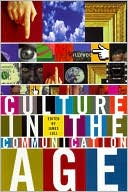

 |

|

The average rating for Culture in the Communication Age based on 2 reviews is 5 stars.
Review # 1 was written on 2016-12-21 00:00:00 Robert Patton Robert PattonThis was an excellent book that I read much too quickly to absorb all that it had to offer. However, it made many points about how anthropology and the examination of culture need to be modified or to take into consideration the changes that have occurred as a result of technology. The first essay was an interesting one about the formation of cultures. Humans were in a situation of predator-prey in regard to other animals. In order to survive humans needed to compensate for their physical weakness by using their brains and also by banding together into groups. An analysis of cave paintings strengthened this point by seeing the drawing of animals and hunters as a way of gaining power. This uneasy relationship between predator/prey has characterized human behavior since according to this author, transferring the enemy into other humans. The themes of biology and community although not dealt with as directly in other essays hovers over the discussions. Characteristic of this book is that the authors represent different cultures. This worldwide approach is necessary in books dealing with a globalized culture. One essay that I found particularly interesting was the one by a Finnish woman who talked about the differences in gender in her country and the United States. There are still gender advantages for males, but they are different and come from different assumptions. Women have more political power in Finland, but there are still cultural issues. Many of the articles discussed the impact of world wide media dissemination. On the whole the authors had a more positive take than the Frankfurt school on the impact of mass media. One article talked about printing as a visual medium followed by photography, movies and television. Photography rather quickly lost its status as a medium representing actual reality. One thinks of Brady arranging those bodies in his Civil War photographs. A number of articles mentioned a study by Lang I believe of the MacArthur parade that showed the difference between the photographic representation and the actual event. With digital manipulation, photographs are even more suspect. The author made the claim that although it is acknowledged that printing led to an advance in cognitive thinking, the positive effects on cognition of visual representations has not been acknowledged because schools are based around a verbal curriculum. That heavy viewers may do less well in school may not be a comment on the cognitive abilities of the students, but on the limitations of the school. Another author looked at the function of the star. We decry celebrities but they may be the glue that helps hold societies together. An important point taken believe it or not from Aristotle is not to look at the heroes but to see what these heroes tell us about audiences. I sensed the possibility for a good critique of Joseph Campbell since the heroes were as false as the stars are. Stars can tell us about their fans since not everyone becomes a star. We have been looking in the wrong place. I like this because it is much more interesting and also because it makes the point that we must not underrate the audience. There was a lot about what Princess Di's funeral told us about her mourners. The world was pulled together watching the service in which tradition was mingled with the popular such as Elton John's song and her brother's critique of the royal family and the media. The issue of popular culture was dealt with in an interesting way contrasted with elite and folk and mass culture, all a question in some ways of definition, but important in terms of some of the distinctions. Anthropology first emerged as a colonial study of the other. These essays provided a different slant on the way we need to look at our societies and the complexity of them. In the essay on the Internet, the author made the point that we have so see how it is absorbed into our every day lives. Much was made throughout the book about language and how we live in a world of symbols. The authors connected to the past but with modifying perspectives as they looked at the pioneer students of culture. There was a great deal about how technology modifies time and space and the metaphor of the highway rather than the road that one can walk. Cultures were being changed but not necessarily destroyed because of the complex of different experiences and images each individual absorbed. There was a good deal of discussion about identity and how it is formed in the 21st century. One needed to adjust to references to the last century being about the 20th. I hope we don't forget the 19th century, however. It is one of my favorite centuries. This book obviously stimulated a great deal of thought. The bibliographies at the end of each chapter made me want to buy more books. |
Review # 2 was written on 2017-06-19 00:00:00 Josephine Stiess Josephine Stiessهناك نوعيتان من الكتاب ... نوعية تدفعك لأن تقرأ، وأخرى تدفعك لأن تكتب ... وقلة تلك الكتب التي تدفعك إلى مزيد من القراءة والكتابة في آن واحد ... بالنسبة لهذا الكتاب، أحببت فيه وضعه لبذور التأريخ للكتاب في العصر الإسلامي .. بل لنقل للكتاب في ظل الإسلام ... سواء كوسيلة اتصال، او كظاهرة من الطواهر الاجتماعية المؤثرة على الحياة الإنسانية ... هذا الكتاب من الناحية الشخصية يدفعني للكتابة.. وكم ابتعدت عني الكتابة في الأشهر القليلة الماضية .. لكن الكلمات حتماً ستعود.. |
CAN'T FIND WHAT YOU'RE LOOKING FOR? CLICK HERE!!!